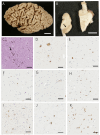Frontotemporal Lobar degeneration with TDP-43 presenting as progressive supranuclear palsy syndrome
- PMID: 40635087
- PMCID: PMC12239482
- DOI: 10.1186/s40478-025-02058-0
Frontotemporal Lobar degeneration with TDP-43 presenting as progressive supranuclear palsy syndrome
Abstract
Objective: Frontotemporal lobar degeneration with TDP-43 pathology (FTLD) usually presents with frontotemporal dementia, semantic aphasia or progressive nonfluent aphasia. Corticobasal syndrome and atypical parkinsonism have been occasionally reported, but progressive supranuclear palsy (PSP) syndrome (also known as Richardson syndrome (RS)) has not been reported in patients with FTLD-TDP. In this study we report clinical and pathologic characteristics of FTLD-TDP, clinically diagnosed as PSP syndrome (FTLD-TDP-PSP).
Methods: We reviewed clinical information of 270 patients with FTLD-TDP from the Mayo Clinic brain bank and identified 5 patients with FTLD-TDP-PSP. As a control group, we selected ten consecutive patients of pathologically confirmed PSP with clinical presentations of PSP syndrome (PSP-RS). We compared the clinical and pathological features of FTLD-TDP-PSP and PSP-RS.
Results: The most common clinical symptoms in FTLD-TDP-PSP were memory loss (100%) followed by parkinsonism (80%), early falls (60%), and behavioral variant FTD (60%). All patients with PSP-RS met the Movement Disorder Society's criteria for probable PSP, while only one FTLD-TDP-PSP met the probable PSP. Two of the five patients with FTLD-TDP-PSP had moderate or severe neuronal loss in the substantia nigra and one had moderate or severe neuronal loss in the putamen and globus pallidus.
Conclusion: A small subset of patients with FTLD-TDP can, in rare instances, present with symptoms associated with PSP. Therefore, FTLD-TDP may be considered in differential diagnosis, especially in patients who do not meet the diagnostic criteria. Our findings emphasize the need for further clinical and biomarker studies of FTLD-TDP.
Keywords: Frontotemporal Lobar degeneration; Progressive supranuclear palsy; TDP-43.
© 2025. The Author(s).
Conflict of interest statement
Declarations. Ethics approval and consent to participate: Brain autopsies were obtained after consent of the legal next-of-kin and studies of this type are considered exempt from human subject research. The Mayo Clinic brain bank operates under protocols approved by the Mayo Clinic Institutional Review Board. Consent for publication: Not applicable. Competing interests: The authors declare no competing interests. Financial disclosures of all authors for the preceding 12 months: AM received speaker fees (royalties) from Chugai Pharmaceutical Co., Ltd. And supported by a JSPS KAKENHI Grant-in-Aid for Early-Career Scientists #23K14764. YY received speaker fees (royalties) from the following companies: Daiichi Sankyo Company, Limited; Otsuka Pharmaceutical Co., Ltd.; Eisai Co., Ltd.; Chugai Pharmaceutical Co., Ltd.; Takeda Pharmaceutical Co., Ltd.; Kyowa Kirin Co., Ltd.; Alexion Pharmaceuticals, Inc.; EA Pharma Co., Ltd.; Ono Pharmaceutical Co., Ltd.; Kowa Co., Ltd.; Novartis Pharma K.K.; UCB Japan Co., Ltd.; and Eli Lilly Japan K.K. and supported by a JSPS KAKENHI Grant-in-Aid for Scientific Research (C) #24K13494. SK, HS, and DWD have no financial disclosures to declare.
Figures



Similar articles
-
Transdiagnostic Network Localization of Social, Language, and Motor Symptoms in Patients With Frontotemporal Lobar Degeneration.Neurology. 2024 Dec 24;103(12):e210108. doi: 10.1212/WNL.0000000000210108. Epub 2024 Nov 25. Neurology. 2024. PMID: 39586043
-
Methylome analysis of FTLD patients with TDP-43 pathology identifies epigenetic signatures specific to pathological subtypes.Mol Neurodegener. 2025 Jul 6;20(1):80. doi: 10.1186/s13024-025-00869-2. Mol Neurodegener. 2025. PMID: 40619440 Free PMC article.
-
DNA methylation as a contributor to dysregulation of STX6 and other frontotemporal Lobar degeneration genetic risk-associated loci.Acta Neuropathol Commun. 2025 Jul 5;13(1):148. doi: 10.1186/s40478-025-02071-3. Acta Neuropathol Commun. 2025. PMID: 40618089 Free PMC article.
-
Which ante mortem clinical features predict progressive supranuclear palsy pathology?Mov Disord. 2017 Jul;32(7):995-1005. doi: 10.1002/mds.27034. Epub 2017 May 13. Mov Disord. 2017. PMID: 28500752 Free PMC article.
-
Progressive supranuclear palsy (PSP): Richardson syndrome and other PSP variants.Acta Neurol Scand. 2016 Oct;134(4):242-9. doi: 10.1111/ane.12546. Epub 2016 Jan 6. Acta Neurol Scand. 2016. PMID: 27070344 Free PMC article.
References
-
- Al-Sarraj S, King A, Troakes C, Smith B, Maekawa S, Bodi I, Rogelj B, Al-Chalabi A, Hortobágyi T, Shaw CE (2011) p62 positive, TDP-43 negative, neuronal cytoplasmic and intranuclear inclusions in the cerebellum and hippocampus define the pathology of C9orf72-linked FTLD and MND/ALS. Acta Neuropathol 122:691–702. 10.1007/s00401-011-0911-2 - PubMed
-
- Braak H, Braak E (1991) Neuropathological stageing of Alzheimer-related changes. Acta Neuropathol 82:239–259. 10.1007/bf00308809 - PubMed
-
- Calabresi P, Picconi B, Tozzi A, Ghiglieri V, Di Filippo M (2014) Direct and indirect pathways of basal ganglia: a critical reappraisal. Nat Neurosci 17:1022–1030. 10.1038/nn.3743 - PubMed
MeSH terms
Substances
Grants and funding
LinkOut - more resources
Full Text Sources
Medical
Research Materials
Miscellaneous

